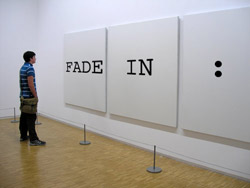 What the eff?
What the eff?
So I was happily writing an article about common mistakes people make on the first page of their script, when I recalled a suggestion by William M. Akers, that I’d previously written about.
In his great book, “Your Screenplay Sucks! 100 ways to make it great,” he advises the following (on page 203):
… take a gander at the fact that FADE IN: has one space underneath it. If you’re like me and you have two spaces above every slugline (or “Scene Heading” in Final Draft) then you’ll need to adjust the very first slugline so FADE IN: only has one space below it.
Good advice right? Ever since reading his book, it’s bothered me whenever I’ve seen the double line spacing after FADE IN:
But here’s the problem… I can’t find any real world examples of this rule having been implemented! NOT A SINGLE ONE. At least not from professional or production scripts, or spec scripts that later sold.
Instead what I found after going through my script library was:
- When scripts have two line spaces above the scene headings, there are two line spaces after FADE IN:
- When scripts have one line space above scene headings, there is one line space after FADE IN:
Sorta logical really. Hmm…
What do the screenplay formatting guides say?
Here’s what I checked:
– The Screenwriter’s Bible by David Trottier
– The Hollywood Standard by Christopher Riley
Curiously, neither formatting guide offers any insight into the line spacing that should come after a TRANSITION. And definitely nothing prescriptive of a single line space after FADE IN: (At least nothing I could find.)
To top it off
You’d think if there were an industry standard for such a thing, the screenwriting program, Final Draft, would automatically correct the error for all of the transitions. But alas it does not.
What do you do?
I want to hear from you. Do you follow William Akers’ rule (i.e. one line space after FADE IN: even though you have two line spaces above your scene headings)? Can you cite a non-amateur script example of Akers’ rule being followed?
Mr. Akers — if you happen by this site, I’d love it if you could send me an email to discuss, or post a comment below, to explain the discrepancy.
Does anyone else obsess over these kinds of details like I do?… On a Friday night… [cough]





I randomly went through ten non-amateur scripts and the first nine didn’t even use FADE IN at all! They just started with a scene heading or even just an action line. This script has one space after FADE IN and two spaces above each scene heading:
http://www.horrorlair.com/movies/scripts/Vacancy.pdf
Is that what you mean?
Booyah — that’s exactly what I was looking for! Nice job Teddy. Your script library Kung Fu is obviously greater than mine.
Though it’s interesting that the writer, Mark L. Smith, doesn’t follow the rule for the remaining CUT TO: transistions — which, according to Akers, should also only have one line space beneath them.
And yeah, you’re so right — so many modern scripts these days don’t even use FADE IN: at all. And some pros even right justify the FADE IN: (though I’d highly recommend that amateur writers not do that, as it’s still very non-standard).
What a world, what world!
Anyway, thanks for taking the time to look through your scripts and post a comment. Much appreciated!
Standard format through years of Hollywood history called for a single blank line after a FADE IN:. Scripts rarely follow that rule today because of an anomaly with Final Draft software which automatically inserts two blank lines before each shot heading, even when a shot heading follows a FADE IN:. I’ve always believed that this represents an unintentional error on the part of Final Draft’s programers. That’s now water under the bridge. Thanks to Final Draft’s error (and their market dominance), today’s readers are accustomed to seeing two blank lines after a FADE IN:, so you can safely allow Final Draft to format your script that way. The only downside: It will cost you a line that could otherwise be filled with the magic of storytelling.
Christopher Riley
author, The Hollywood Standard
Christopher! So wonderful of you to drop by the site and solve this mystery. Thanks!! Promoting this comment to the front page…
Mr. Akers suggestion about how to handle the “double line” below FADE IN: in Final Draft is concise. The only problem is that if you change the first slugline/Scene Heading spacing, Final Draft changes every other slugline/Scene Heading as well. There is no way to dictate different spacing for various sluglines.
After spending about 30 minutes trying to figure out how to “fix” this “problem” I searched for an answer and found this thread. Result: I am not going to worry about the FADE IN:/ first slugline spacing.
Hi Peter, that’s actually not true. I change the specific line spacing for scene headings all the time (because I use a single line space for all my secondary scene headings).
Simply click on the heading you want to change the line spacing above. Then go to Format > Space Before > 1.
I do it so often that I customized my toolbar with “Space Before – 1” and “Space Before – 2.”
Cheers!